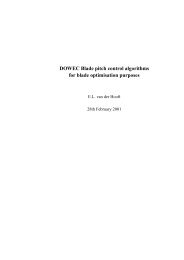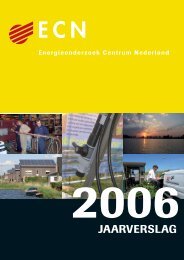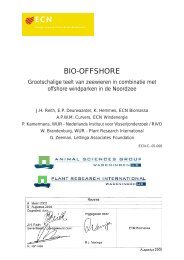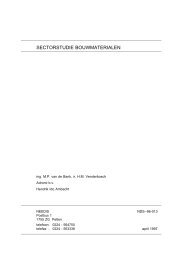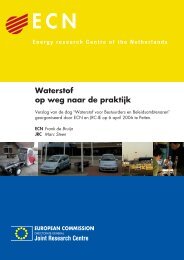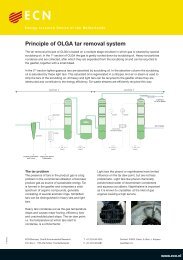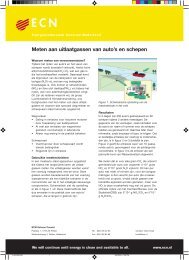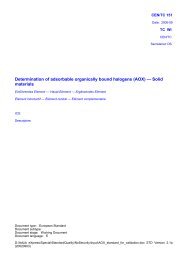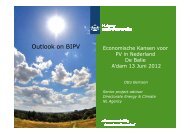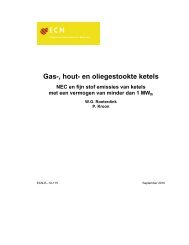PDF format (503 kB) - ECN
PDF format (503 kB) - ECN
PDF format (503 kB) - ECN
Create successful ePaper yourself
Turn your PDF publications into a flip-book with our unique Google optimized e-Paper software.
uid metal as the product; it did not include the subsequent, product-specific, less energy intensive processes for<br />
casting, rolling and finishing, mainly important for their material efficiency.<br />
Calculations of emissions and costs of the production routes took place by process analysis and aggregation of<br />
the individual processes into production routes. First, individual process data were collected, including consumption<br />
and production and data on investment and operation costs [1-9,11,12,14-18,21-23]. Stacking of the<br />
processes into production routes allowed calculation of the consumption and production data per unit product.<br />
Subsequent combination of these data with prices [9], carbon contents and CO2 emission factors resulted in<br />
costs and CO2 emissions for each product.<br />
As always in process analysis, system boundaries presented a problem. As all selected production routes use<br />
electricity or produce excess energy, the CO2 emissions to be attributed to the production routes depended on<br />
the technology applied outside the base metal industry. Therefore, the emissions were calculated for two CO2<br />
emission factors of the electricity production, of 0 and 0.1 tonne CO2 per GJe. Nuclear, solar, wind and water<br />
based power plants or fossil power plants with CO2 removal results in a (near) zero emission factor, while 0.1<br />
tonne CO2 per GJe represents the current European average. Conversion of excess energy emerging from a production<br />
route to electricity at an efficiency of 40% allowed subtraction of the avoided CO2 emissions in the<br />
electricity sector from the emissions by steel production. Steam production may also have varying emissions.<br />
There is no separate scenario: 0.06 t CO2 per GJ steam emission factor accompanies the high electricity emissions<br />
factor; zero emissions for steam accompany the zero electricity emissions factor.<br />
For steel, two additional, partly external parameters were used to define scenarios. For both scrap addition and<br />
CO2 removal two additional scenario parameters were defined, resulting in a total of 8 scenarios. The steelmaker<br />
decides on scrap addition, but the possibilities for scrap addition strongly depend on external factors.<br />
Likewise, CO2 removal is a technique applied by the steel producer, but transport and storage require external<br />
infrastructure, involving external decision makers.<br />
Steel Production<br />
The selection of steel production routes, listed in table 1, represents the four main types of liquid steel production,<br />
namely the blast furnace, smelting-reduction, direct reduction and scrap based routes, with two of each. In<br />
the EC, 1993, the conventional blast furnace route accounted for about 88 million tonnes crude steel, and scrap<br />
based electric steelmaking for about 44 million tonnes [10], with application of best practice techiques resulting<br />
in over 150 and 9 Mt CO2 emissions, respectively.<br />
Table 1 Important characteristics of the production routes<br />
Route Energy input Energy output Number of<br />
processes<br />
CO2 removal<br />
Proces Type GJtot * GJe* Gas* Steam* Total CO2 rate ECU/t<br />
removal** % CO2***<br />
BF150 coal 19.6 3.1 5 1 (p) 80 32<br />
BF250 coal 16.7 2.5 5 1 (p) 90 30<br />
COREX coal 28.3 10.8 4 1 (p) 90 30<br />
CCF coal 18.8 3.5 5.5 3 1 (p) 90 30<br />
MIDREX gas, electricity 14.3 1.6 3 1 (s) 90 10<br />
Circofer coal,<br />
electricity<br />
16.1 1.6 3 1 (s) 90 10<br />
ACEAF electricity 1.7 1.4 1<br />
DCEAF electricity, coal 1.7 0.9 1<br />
* Values for low scrap addition, GJ per tonne steel. **(p) indicates that removal is possible, (s) that removal is part of<br />
tion. *** total of removal, transport and storage.<br />
normal process opera-<br />
A thorough description of all processes in detail would be too elaborate, but it is essential to provide some<br />
background in<strong>format</strong>ion on the analysed production routes. Table 1 lists some characteristics of the the produc-



